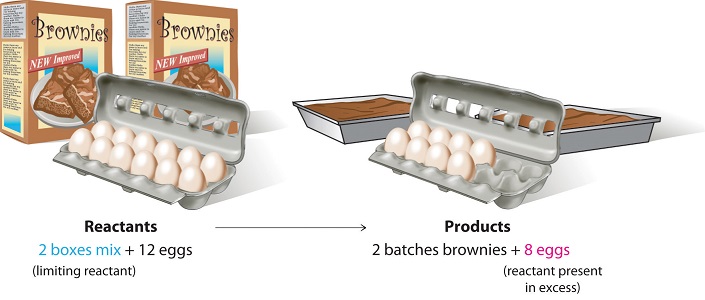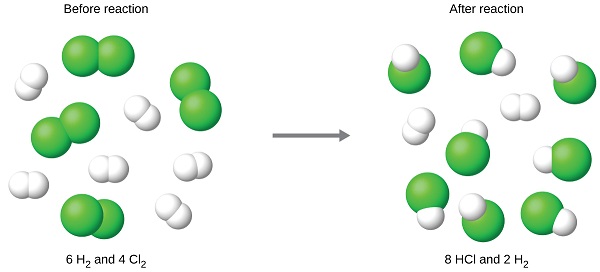3.10: Limiting Reactant
- Page ID
- 423628
\( \newcommand{\vecs}[1]{\overset { \scriptstyle \rightharpoonup} {\mathbf{#1}} } \)
\( \newcommand{\vecd}[1]{\overset{-\!-\!\rightharpoonup}{\vphantom{a}\smash {#1}}} \)
\( \newcommand{\id}{\mathrm{id}}\) \( \newcommand{\Span}{\mathrm{span}}\)
( \newcommand{\kernel}{\mathrm{null}\,}\) \( \newcommand{\range}{\mathrm{range}\,}\)
\( \newcommand{\RealPart}{\mathrm{Re}}\) \( \newcommand{\ImaginaryPart}{\mathrm{Im}}\)
\( \newcommand{\Argument}{\mathrm{Arg}}\) \( \newcommand{\norm}[1]{\| #1 \|}\)
\( \newcommand{\inner}[2]{\langle #1, #2 \rangle}\)
\( \newcommand{\Span}{\mathrm{span}}\)
\( \newcommand{\id}{\mathrm{id}}\)
\( \newcommand{\Span}{\mathrm{span}}\)
\( \newcommand{\kernel}{\mathrm{null}\,}\)
\( \newcommand{\range}{\mathrm{range}\,}\)
\( \newcommand{\RealPart}{\mathrm{Re}}\)
\( \newcommand{\ImaginaryPart}{\mathrm{Im}}\)
\( \newcommand{\Argument}{\mathrm{Arg}}\)
\( \newcommand{\norm}[1]{\| #1 \|}\)
\( \newcommand{\inner}[2]{\langle #1, #2 \rangle}\)
\( \newcommand{\Span}{\mathrm{span}}\) \( \newcommand{\AA}{\unicode[.8,0]{x212B}}\)
\( \newcommand{\vectorA}[1]{\vec{#1}} % arrow\)
\( \newcommand{\vectorAt}[1]{\vec{\text{#1}}} % arrow\)
\( \newcommand{\vectorB}[1]{\overset { \scriptstyle \rightharpoonup} {\mathbf{#1}} } \)
\( \newcommand{\vectorC}[1]{\textbf{#1}} \)
\( \newcommand{\vectorD}[1]{\overrightarrow{#1}} \)
\( \newcommand{\vectorDt}[1]{\overrightarrow{\text{#1}}} \)
\( \newcommand{\vectE}[1]{\overset{-\!-\!\rightharpoonup}{\vphantom{a}\smash{\mathbf {#1}}}} \)
\( \newcommand{\vecs}[1]{\overset { \scriptstyle \rightharpoonup} {\mathbf{#1}} } \)
\( \newcommand{\vecd}[1]{\overset{-\!-\!\rightharpoonup}{\vphantom{a}\smash {#1}}} \)
\(\newcommand{\avec}{\mathbf a}\) \(\newcommand{\bvec}{\mathbf b}\) \(\newcommand{\cvec}{\mathbf c}\) \(\newcommand{\dvec}{\mathbf d}\) \(\newcommand{\dtil}{\widetilde{\mathbf d}}\) \(\newcommand{\evec}{\mathbf e}\) \(\newcommand{\fvec}{\mathbf f}\) \(\newcommand{\nvec}{\mathbf n}\) \(\newcommand{\pvec}{\mathbf p}\) \(\newcommand{\qvec}{\mathbf q}\) \(\newcommand{\svec}{\mathbf s}\) \(\newcommand{\tvec}{\mathbf t}\) \(\newcommand{\uvec}{\mathbf u}\) \(\newcommand{\vvec}{\mathbf v}\) \(\newcommand{\wvec}{\mathbf w}\) \(\newcommand{\xvec}{\mathbf x}\) \(\newcommand{\yvec}{\mathbf y}\) \(\newcommand{\zvec}{\mathbf z}\) \(\newcommand{\rvec}{\mathbf r}\) \(\newcommand{\mvec}{\mathbf m}\) \(\newcommand{\zerovec}{\mathbf 0}\) \(\newcommand{\onevec}{\mathbf 1}\) \(\newcommand{\real}{\mathbb R}\) \(\newcommand{\twovec}[2]{\left[\begin{array}{r}#1 \\ #2 \end{array}\right]}\) \(\newcommand{\ctwovec}[2]{\left[\begin{array}{c}#1 \\ #2 \end{array}\right]}\) \(\newcommand{\threevec}[3]{\left[\begin{array}{r}#1 \\ #2 \\ #3 \end{array}\right]}\) \(\newcommand{\cthreevec}[3]{\left[\begin{array}{c}#1 \\ #2 \\ #3 \end{array}\right]}\) \(\newcommand{\fourvec}[4]{\left[\begin{array}{r}#1 \\ #2 \\ #3 \\ #4 \end{array}\right]}\) \(\newcommand{\cfourvec}[4]{\left[\begin{array}{c}#1 \\ #2 \\ #3 \\ #4 \end{array}\right]}\) \(\newcommand{\fivevec}[5]{\left[\begin{array}{r}#1 \\ #2 \\ #3 \\ #4 \\ #5 \\ \end{array}\right]}\) \(\newcommand{\cfivevec}[5]{\left[\begin{array}{c}#1 \\ #2 \\ #3 \\ #4 \\ #5 \\ \end{array}\right]}\) \(\newcommand{\mattwo}[4]{\left[\begin{array}{rr}#1 \amp #2 \\ #3 \amp #4 \\ \end{array}\right]}\) \(\newcommand{\laspan}[1]{\text{Span}\{#1\}}\) \(\newcommand{\bcal}{\cal B}\) \(\newcommand{\ccal}{\cal C}\) \(\newcommand{\scal}{\cal S}\) \(\newcommand{\wcal}{\cal W}\) \(\newcommand{\ecal}{\cal E}\) \(\newcommand{\coords}[2]{\left\{#1\right\}_{#2}}\) \(\newcommand{\gray}[1]{\color{gray}{#1}}\) \(\newcommand{\lgray}[1]{\color{lightgray}{#1}}\) \(\newcommand{\rank}{\operatorname{rank}}\) \(\newcommand{\row}{\text{Row}}\) \(\newcommand{\col}{\text{Col}}\) \(\renewcommand{\row}{\text{Row}}\) \(\newcommand{\nul}{\text{Nul}}\) \(\newcommand{\var}{\text{Var}}\) \(\newcommand{\corr}{\text{corr}}\) \(\newcommand{\len}[1]{\left|#1\right|}\) \(\newcommand{\bbar}{\overline{\bvec}}\) \(\newcommand{\bhat}{\widehat{\bvec}}\) \(\newcommand{\bperp}{\bvec^\perp}\) \(\newcommand{\xhat}{\widehat{\xvec}}\) \(\newcommand{\vhat}{\widehat{\vvec}}\) \(\newcommand{\uhat}{\widehat{\uvec}}\) \(\newcommand{\what}{\widehat{\wvec}}\) \(\newcommand{\Sighat}{\widehat{\Sigma}}\) \(\newcommand{\lt}{<}\) \(\newcommand{\gt}{>}\) \(\newcommand{\amp}{&}\) \(\definecolor{fillinmathshade}{gray}{0.9}\)↵
- Identify the limiting reactant (limiting reagent) in a given chemical reaction.
- Calculate how much product will be produced from the limiting reactant.
- Calculate how much reactant(s) remains when the reaction is complete.
In all examples discussed thus far, the reactants were assumed to be present in stoichiometric quantities. Consequently, none of the reactants were left over at the end of the reaction. This is often desirable—as in the case of a space shuttle—where excess oxygen or hydrogen is not only extra freight to be hauled into orbit, but also an explosion hazard. More often, however, reactants are present in mole ratios that are not the same as the ratio of the coefficients in the balanced chemical equation. As a result, one or more of them will not be used up completely, but will be left over when the reaction is completed. In this situation, the amount of product that can be obtained is limited by the amount of only one of the reactants. The reactant that restricts the amount of product obtained is called the limiting reactant. The reactant that remains after a reaction has gone to completion is in excess.
Consider a nonchemical example. Assume you have invited some friends for dinner and want to bake brownies for dessert. You find two boxes of brownie mix in your pantry and see that each package requires two eggs. The balanced equation for brownie preparation is:
\[ 1 \,\text{box mix} + 2 \,\text{eggs} \rightarrow 1 \, \text{batch brownies} \label{3.7.1} \]
If you have a dozen eggs, which ingredient will determine the number of batches of brownies that you can prepare? Because each box of brownie mix requires two eggs and you have two boxes, you need four eggs. Twelve eggs is eight more eggs than you need. Although the ratio of eggs to boxes in is 2:1, the ratio in your possession is 6:1. Hence the eggs are the ingredient (reactant) present in excess, and the brownie mix is the limiting reactant. Even if you had a refrigerator full of eggs, you could make only two batches of brownies.

View this interactive simulation illustrating the concepts of limiting and excess reactants.
Consider this concept now with regard to a chemical process, the reaction of hydrogen with chlorine to yield hydrogen chloride:
The balanced equation shows that hydrogen and chlorine react in a 1:1 stoichiometric ratio. If these reactants are provided in any other amounts, one of the reactants will nearly always be entirely consumed, thus limiting the amount of product that may be generated. This substance is the limiting reactant, and the other substance is the excess reactant.
To identify the limiting reactant, you can compare the amount of product expected for the complete reaction of each reactant. Each reactant amount is used to separately calculate the amount of product that would be formed per the reaction stoichiometry. The reactant yielding the lesser amount of product is the limiting reactant. For the example, in the previous paragraph, complete reaction of the hydrogen would yield:
\[\mathrm{mol\: HCl\: produced=3\: mol\:H_2\times \dfrac{2\: mol\: HCl}{1\: mol\:H_2}=6\: mol\: HCl} \nonumber \]
Complete reaction of the provided chlorine would produce:
\[\mathrm{mol\: HCl\: produced=2\: mol\:Cl_2\times \dfrac{2\: mol\: HCl}{1\: mol\:Cl_2}=4\: mol\: HCl} \nonumber \]
The chlorine will be completely consumed once 4 moles of HCl have been produced. Since enough hydrogen was provided to yield 6 moles of HCl, there will be non-reacted hydrogen remaining once this reaction is complete. Chlorine, therefore, is the limiting reactant and hydrogen is the excess reactant (Figure \(\PageIndex{2}\)).

A similar situation exists for many chemical reactions: you usually run out of one reactant before all of the other reactant has reacted. The reactant you run out of is called the limiting reactant; the other reactant or reactants are considered to be in excess.
Find the limiting reactant by calculating and comparing the amount of product that each reactant will produce.
- Balance the chemical equation for the chemical reaction.
- Convert the given information into moles.
- Use stoichiometry for each individual reactant to find the mass of product produced.
- The reactant that produces a lesser amount of product is the limiting reactant and the reactant that produces a larger amount of product is the excess reactant
As an example, consider the balanced equation
\[\ce{4 C2H3Br3 + 11 O2 \rightarrow 8 CO2 + 6 H2O + 6 Br2} \nonumber \]
What is the limiting reactant if 76.4 grams of \(\ce{C_2H_3Br_3}\) reacted with 49.1 grams of \(\ce{O_2}\)?
Solution
Step 1: Balance the chemical equation.
The equation is already balanced with the relationship
4 mol C2H3Br3 to 11 mol O2 to 6 mol H2O to 6 mol Br2
Step 2 and Step 3: Convert mass to moles and use stoichiometric ratios. Set up two calculations - one for each reactant.
\[\mathrm{76.4\:\cancel{g\: C_2H_3Br_3} \times \dfrac{1\: \cancel{mol\: C_2H_3Br_3}}{266.72\:\cancel{g\: C_2H_3Br_3}} \times \dfrac{8\: \cancel{mol\: CO_2}}{4\: \cancel{mol\: C_2H_3Br_3}} \times \dfrac{44.01\:g\: CO_2}{1\: \cancel{mol\: CO_2}} = 25.2\:g\: CO_2} \nonumber \]
\[\mathrm{49.1\: \cancel{ g\: O_2} \times \dfrac{1\: \cancel{ mol\: O_2}}{32.00\: \cancel{ g\: O_2}} \times \dfrac{8\: \cancel{ mol\: CO_2}}{11\: \cancel{ mol\: O_2}} \times \dfrac{44.01\:g\: CO_2}{1\: \cancel{ mol\: CO_2}} = 49.1\:g\: CO_2} \nonumber \]
Step 4: The reactant that produces a smaller amount of product is the limiting reactant.
\(\ce{C2H3Br3}\) is the limiting reactant.
Calculate the mass of magnesium oxide that can be produced if 2.40 g \(Mg\) reacts with 10.0 g \(O_2\). The balanced chemical reaction is 2 Mg (s) + O2 (g) → 2 MgO (s)
Solution
Step 1: Balance the chemical equation.
The equation is already balanced. The balanced equation provides the relationship of 2 mol Mg to 1 mol O2 to 2 mol MgO
Step 2 and Step 3: Convert mass to moles and use stoichiometric ratios. Set up two calculations - one for each reactant.
\[\mathrm{2.40\:\cancel{g\: Mg }\times \dfrac{1\: \cancel{mol\: Mg}}{24.31\:\cancel{g\: Mg}} \times \dfrac{2\: \cancel{mol\: MgO}}{2\: \cancel{mol\: Mg}} \times \dfrac{40.31\:g\: MgO}{1\: \cancel{mol\: MgO}} = 3.98\:g\: MgO} \nonumber \]
\[\mathrm{10.0\:\cancel{g\: O_2}\times \dfrac{1\: \cancel{mol\: O_2}}{32.00\:\cancel{g\: O_2}} \times \dfrac{2\: \cancel{mol\: MgO}}{1\:\cancel{ mol\: O_2}} \times \dfrac{40.31\:g\: MgO}{1\: \cancel{mol\: MgO}} = 25.2\: g\: MgO} \nonumber \]
Step 4: The reactant that produces a smaller amount of product is the limiting reactant.
Mg produces less MgO than does O2 (3.98 g MgO vs. 25.2 g MgO), therefore Mg is the limiting reactant in this reaction and O2 is the excess reactant.
What is the limiting reactant if 78.0 grams of Na2O2 were reacted with 29.4 grams of H2O? The unbalanced chemical equation is \[\ce{Na2O2 (s) + H2O (l) → NaOH (aq) + H2O2 (l)} \nonumber \]
Solution
| Steps for Problem Solving | Example \(\PageIndex{1}\) |
|---|---|
| Identify the "given" information and what the problem is asking you to "find." |
Given: 78.0 grams of Na2O2 29.4 g H2O Find: limiting reactant |
| List other known quantities. |
1 mol Na2O2= 77.96 g/mol |
| Balance the equation. |
Na2O2 (s) + 2H2O (l) → 2NaOH (aq) + H2O2 (l) The balanced equation provides the relationship of 1 mol Na2O2 to 2 mol H2O 2mol NaOH to 1 mol H2O2 |
| Prepare a concept map and use the proper conversion factor. |
Because the question only asks for the limiting reactant, we can perform two mass-mole calculations and determine which amount is less. |
| Cancel units and calculate. |
\[\mathrm{78.0\:g\: Na_2O_2 \times \dfrac{1\: mol\: Na_2O_2}{77.96\:g\: Na_2O_2} \times \dfrac{2\: mol\: NaOH}{1\: mol\: Na_2O_2} \times \dfrac{40\:g\: NaOH}{1\: mol\: NaOH} = 2.00\:mol\: NaOH} \nonumber \] \[\mathrm{29.4\:g\: H_2O \times \dfrac{1\: mol\: H_2O}{18.02\:g\: H_2O} \times \dfrac{2\: mol\: NaOH}{2\: mol\: Na_2O_2} \times \dfrac{40\:g\: NaOH}{1\: mol\: NaOH} = 1.63\:mol\: NaOH} \nonumber \] Therefore, H2O is the limiting reactant. |
A 5.00 g quantity of \(\ce{Rb}\) is combined with 3.44 g of \(\ce{MgCl2}\) according to this chemical reaction: \[2R b(s) + MgCl_2(s) → Mg(s) + 2RbCl(s) \nonumber \]
What mass of \(\ce{Mg}\) is formed?
Solution
| Steps for Problem Solving | Example \(\PageIndex{2}\) |
|---|---|
| Steps for Problem Solving |
A 5.00 g quantity of Rb is combined with 3.44 g of MgCl2 according to this chemical reaction: \[2Rb(s) + MgCl_2(s) → Mg(s) + 2RbCl(s) \nonumber \] What mass of Mg is formed, and what mass of remaining reactant is left over? |
| Identify the "given" information and what the problem is asking you to "find." |
Given: 5.00g Rb, 2.44g MgCl2 |
| List other known quantities. |
|
| Prepare concept maps and use the proper conversion factor. |
Find mass Mg formed based on mass of Rb Find mass of Mg formed based on mass of MgCl2 Use limiting reactant to determine amount of excess reactant consumed |
| Cancel units and calculate. |
Because the question asks what mass of magnesium is formed, we can perform two mass-mass calculations and determine which amount is less. \[5.00\cancel{g\, Rb}\times \dfrac{1\cancel{mol\, Rb}}{85.47\cancel{g\, Rb}}\times \dfrac{1\cancel{mol\, Mg}}{2\cancel{mol\, Rb}}\times \dfrac{24.31\, g\, Mg}{\cancel{1\, mol\, Mg}}=0.711\, g\, Mg \nonumber \] \[3.44\cancel{g\, MgCl_{2}}\times \dfrac{1\cancel{mol\, MgCl_{2}}}{95.21\cancel{g\, MgCl_{2}}}\times \dfrac{1\cancel{mol\, Mg}}{1\cancel{mol\, MgCl_{2}}}\times \dfrac{24.31\, g\, Mg}{\cancel{1\, mol\, Mg}}=0.878\, g\, Mg \nonumber \] The 0.711 g of Mg is the lesser quantity, so the associated reactant—5.00 g of Rb—is the limiting reactant. |
Given the initial amounts listed, what is the limiting reactant?
\[\underbrace{22.7\, g}_{MgO(s)}+\underbrace{17.9\, g}_{H_2S}\rightarrow MgS(s)+H_{2}O(l) \nonumber \]
- Answer
- H2S is the limiting reactant

